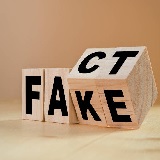|
|
| |
|
|
| |
|
|
|
|
| |
 Lesson
3: Establishing the Truth Lesson
3: Establishing the Truth
The lesson includes a video program, the text for the
video
program, and a words in this story section. |
|
|
|
Lesson 3: Establishing the Truth
Watch the video program about this lesson.
Then read the text and the words in this story section. |
|
|
Lesson 3: Establishing the Truth |
Let’s examine the verification process a little closer.
Becoming a literate news consumer requires us to be able
to identify legitimate journalism. Legitimate journalism
seeks truth. But how do we define that truth?
Truthful reporting comes from using facts that can be
confirmed. All the details may not be known. But a news
story should include the latest version of events based
on verified facts.
Truth is a journey that evolves over time. It is not
possible for us to read one newspaper on one day and get
a complete picture of world events. We must seek out
multiple sources: newspapers, magazines, television and
– yes – the internet.
In Iran recently, massive street demonstrations took
place throughout the country.
When news organizations reported on these events, the
evidence was clear. Images of the protests appeared on
television, in newspapers and on the internet. Literate
news consumers could be certain the demonstrations took
place.
But not all evidence is captured on digital equipment.
Sometimes evidence comes in the most unreliable form –
memory. It is well known that if a police officer
interviews 10 witnesses about a crime, he will receive
10 different versions of events. Yet all were witnesses.
A journalist seeking the truth should interview as many
witnesses as possible in search of the true story.
One of the most exciting developments in the “smart
phone age” is the ability to record events as they
happen.
In May of 2017 former North Charleston, South Carolina
police officer Michael Slager admitted in court to
shooting and killing Walter Scott. But two years
earlier, Officer Slager stated that Scott, pulled over
for a traffic violation, had grabbed for his gun. Many
news organizations reported Slager’s version of the
incident. But the next day, a video emerged clearly
showing that Slager was lying. He shot Scott in the back
as he ran away. News organizations quickly corrected and
updated their earlier reporting.
Verification is the responsibility of both news
organizations and journalists. But a literate news
consumer also checks often for updates or for
corrections in stories because he realizes that
sometimes – even journalists make mistakes.
Next, we will examine balance and fairness.
This lesson is based on the News Literacy class at the
Center for News Literacy at Stony Brook University. For
more on how to become a news literate citizen, go to The
Center for News Literacy. |
|
|
Words in This Story |
-
verification - n.
to quickly take and hold (someone or something) with
your hand or arms
- literate
- adj. one who can
read, write and understand
- consumer
- n. one who uses or
buys things
- journey
- n. a trip
- multiple
- adj. many, more than
one or two
- grab
- v. to quickly take
and hold (someone or something) with your hand or
arms
- emerge
- v. to become known or
apparent
|
|
Source: Voice of America |
|
|
|
|
|
|
|
|
|
|
|
|
|
|
|
|
Search Fun Easy English |
|
|
|
|
|
|
|
|
|
|
|
|
|
|
|
About
Contact
Copyright
Resources
Site Map |